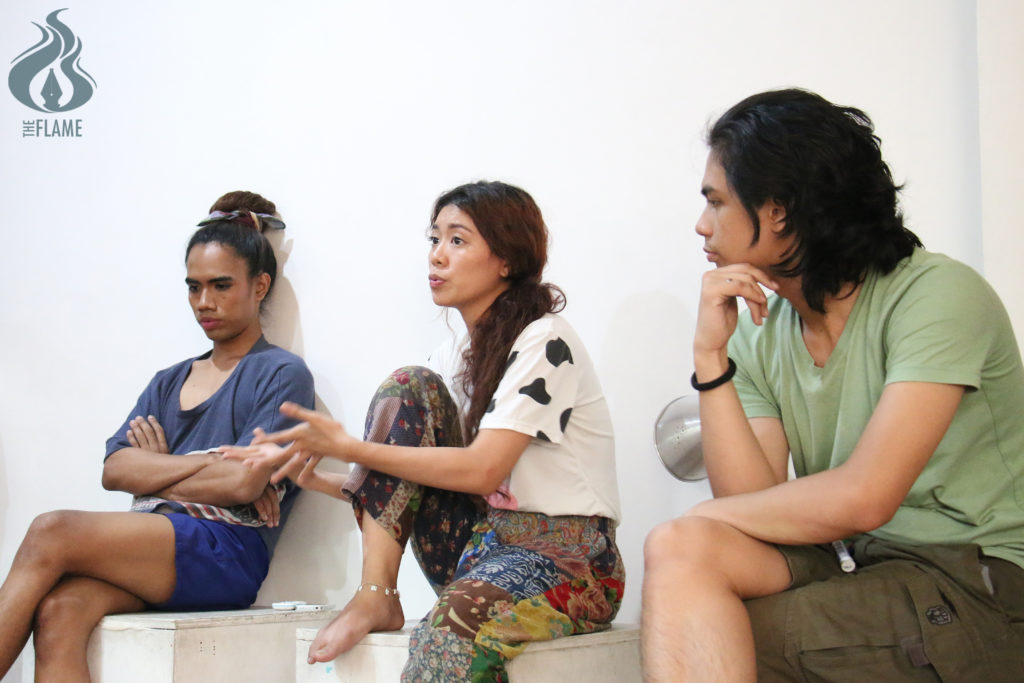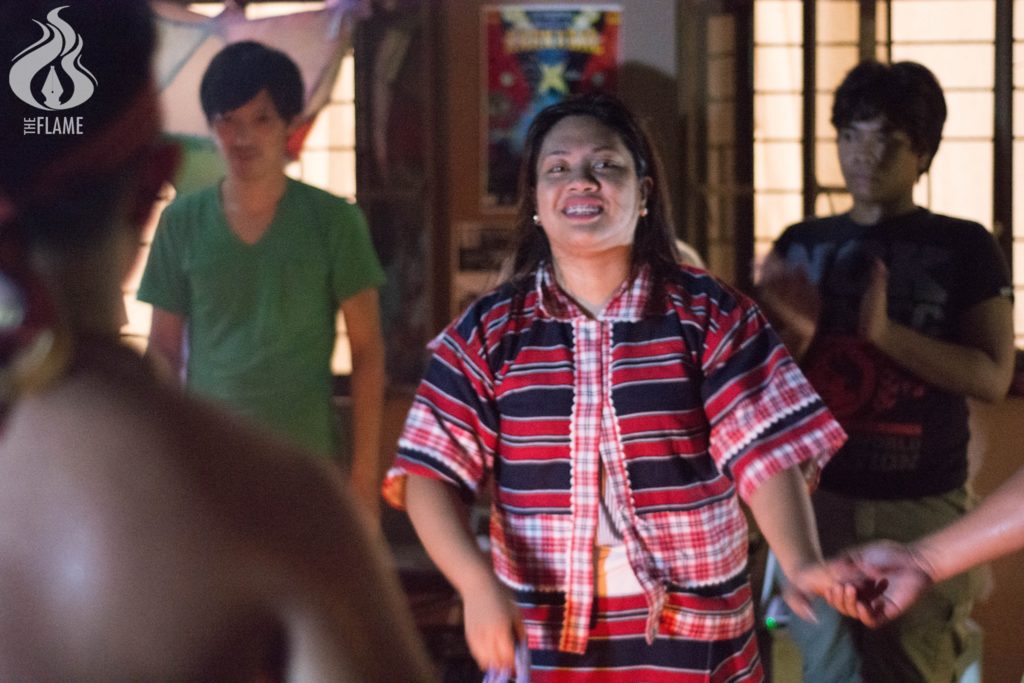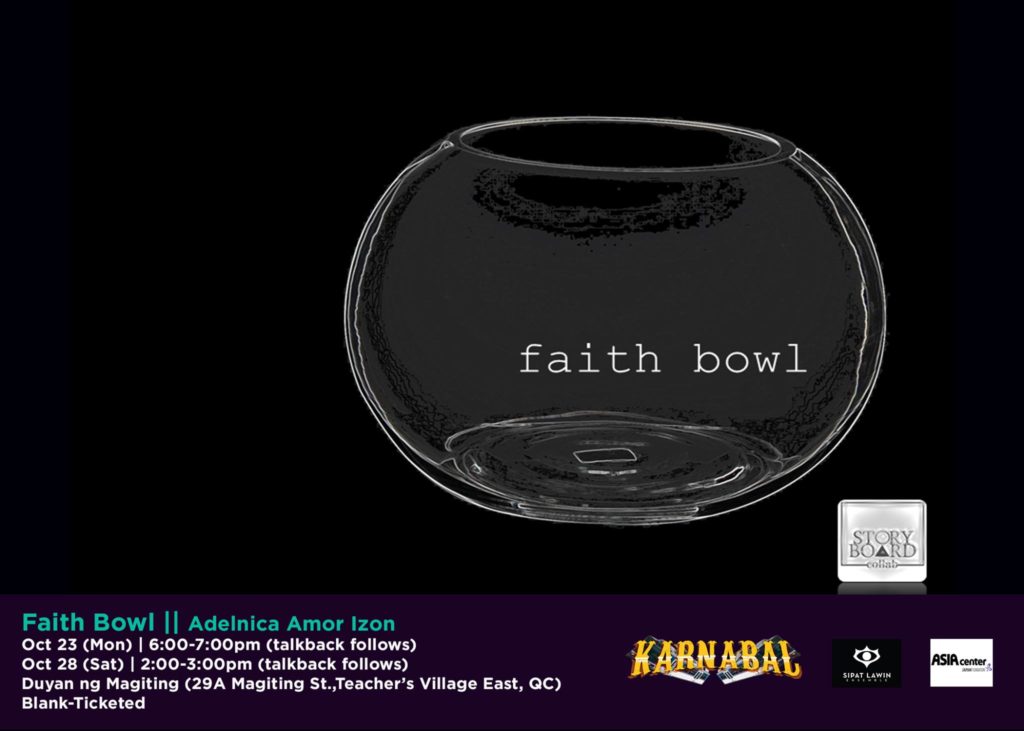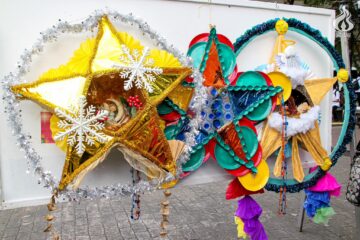By REYANNE LOUISSE AMPONG, ALISHA DANIELLE M. GREGORIO, ANGELA M. SE, AND CARLITO P. TOPACIO
DEVOID OF the typical bearded ladies and strongmen, Karnabal X features a different kind of freak show questioning the very foundation of modern art and serving as a breeding ground for innovative masterpieces.
From Oct. 22 to 29, 10 creative directors from the Lagablab: Karnabal Artist Residency took on the role of ringmasters, alluring the crowd with a variety of contemporary and alternative performance art.
With Maginhawa in their sights, they set up their metaphorical tents in varying locations around the locale, spanning from city landmarks to lesser known residences. Aspiring audience members are the ones who set the fee with the show’s blank ticket system, serving as a feedback system for these experimental artisans and helping them hone their craft as they create a platform for discussion on the current social landscape and art industry.

Talkback on ‘Ghost’ and ‘Once upon a J’
On Karnabal’s fifth day, a series of talkbacks discussed contemporary performance art being underrated and unappreciated by some people.
Bunny Cadag and Cathrine Go’s performances, Once Upon a J and Ghost, respectively, were centers of opinions among the presentations that happened during the previous days.
Cadag, a proud transgender, said his performance is “a response to make the issue of [LGBT] discrimination come into full circle.”
Go said she wanted to highlight the struggle of those who are going through an identity crisis and need inspiration to know themselves better.

‘Gobyerno’: Democracy at center stage
The goal is to create an ideal government and just like how democracy works, Gobyerno: City of Windows is a theatrical performance of the audience, for the audience, and by the audience.
Spearheaded by the Sipat Lawin Ensemble, the performers did not take stage but only facilitated the simulation of the audience to become a government body that will decide on the country’s future.
The performance had two parts, first part is the policy making where the audience will think of issues of this generation and think of ways on how to address it through their policies. The second part is the rehearsal and filming of the documentary of the ideal government that the audience have thought of.
This simulation of a participatory performance was brought about by the ensemble’s view, “if protest is [a] rehearsal for revolution then performance is [an] alternative for an ideal government.”
Although the performance did not involve the entire audience as some chose to observe democracy taking center stage, theatre was revolutionized to become a venue for discussion and the hopes of the people on their ideal government.
Now halfway through its six-year project, “Gobyerno” has already reached countries like Japan, Korea, and Australia partnering with different institutions to collect insights through the performance in order to create a database of different people’s ideal government.

Dap-ay
There was a fusion of tradition and contemporary lifestyle in Dap-ay. The audience had the chance to have a look in the life of Cordilleran ethnolinguistic groups through the cultural songs and dances the performers presented. Most of the audience did not understand what the songs meant for it were sung in its original dialect, but the message of their presentation was truly felt in the emotions of the six performers.
They were all wearing modern clothes, challenging the notion that an Igorot will only be an Igorot once he wears his tribal costume. The presentation then progressed to them wearing different tribal costumes which represent the provinces of the Cordillera region.
Towards the end of the presentation, the Igorots used mobile phones and sang a beautifully rendered mashup of cultural and modern songs like “Salidumay” and “Torete”. This showed that they can keep up with the modern times while all the same preserving their culture and tradition.
Dap-ay was all about Cordilleran identity in the present time. It was more of a presentation than a performance for the Igorots were indeed able to show the audience their practices, the challenges posed to it, and how they act on these challenges.
In the talkback that followed, Roger Federico, a community theater performer and director, said that dap-ay is a Cordilleran political system, a traditional center of education, and a venue for rituals and gatherings. Thus, they chose dap-ay to be the title of their presentation because it tackles who the Igorots are.
“In a way, it is where we discuss our identity since we come from different [ethnolinguistic] groups,” Federico said. He also said that mixing the contemporary with the traditional is their way of making their practices more appealing to the younger generation of Igorots.

“Faith Bowl”: The Human Side of Faith
They came in droves of four, dragging their participants into a sea of questions all contained within a fishbowl. Hive minded and apathetic, this was how members of Iglesia ni Cristo (INC) were often portrayed, but this cannot be farther from the truth.
Serving as the brainchild of Adelnica Amor Izon, Faith Bowl served as a medium for her panel to shed light on the lives of INC members through the guise of a talk show. In hopes of brushing off the misconceptions about their faith, they asked their audience to write down questions about INC. The queries were then placed into a fishbowl from which the panelists would draw from.
The discussion tackled a variety of topics, ranging from the INC lifestyle up to their Church’s take on a variety of issues. The performers also shared stories about their lives, showing the various walks of life and ideologies that the members of their Church had. Throughout the talk show, the panelists all took turns performing spoken word poetries and songs related to the INC.
“Like them (non-INC) we have our own lives. We might have different practices but we’re still human beings.” said Izon.
Without a single effigy or ceremonial garb in sight, these performers adorned themselves with everyday clothes, spoke the common vernacular, and told the most mundane of stories. They seemed as if they were ordinary people, but they were so much more. They were the heroes of Iglesia ni Cristo, a religious group often lambasted with erroneous accusations. In a world knee deep in ignorance, these brave artists dared to preach the truth, one question at a time. F



